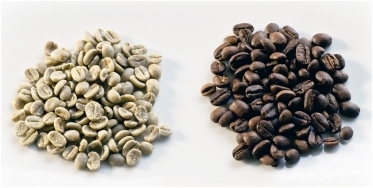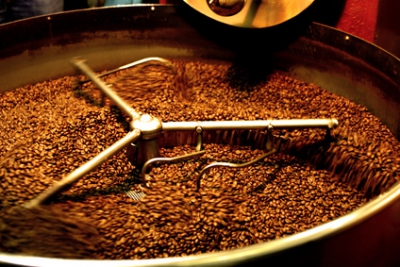In this section we'll briefly discuss the roasting process, discuss the mechanics behind 1st and 2nd crack and summarize some basic chemical changes during this important process.
Basic Overview
Coffee undergoes a dramatic chemical change during the roasting process, giving rise to over 800 compounds with almost one-third representing important aromatic compounds.
In its green form, coffee has a moisture content between 10-12.5% db but after the roasting process dramatically drop to drop about a third. Typically, the roasting process can be characterized in by two important phases - the first crack and second crack - which we'll briefly discuss below.

Green vs Roasted Coffee Beans
The First Crack
When the beans are first dropped into the roaster, a significant drop in temperature is observed as the beans rapidly absorb ambient energy. This first phase of roasting is completely endothermic (heat absorbing) where the vast majority of energy (heat) goes towards the evaporation of water.
In the very early stages of roasting colored plant compounds such as chlorophyll, anthocyanins, etc begin to decompose and the bean changes from a green color to a more yellow/golden color. This color change is typically accompanied with subtle changes in aroma from grassy to more toast/popcorn notes.
As the temperature increase it tends to temporarily stabilize around 100°C (212oF), water within the bean begins to form steam and a pressure gradient is created within the bean. As more and more pressure builds the pressure ruptures the cells within the bean to create audible "pops" known as "first crack".
At this point it's not uncommon for the bean to volume double in volume and begin developing characteristic coffee aromas. Depending on the extent of roasting, moisture levels in the bean be reduced from its initial 10-12% to about 3-5% and a corresponding Agtron value of 95-90.
The Second Crack
The second phase of roasting is accompanied by yet another shorter endothermic phase and a short lived exothermic phase. In the phase a large portion of the free water has been driven and the decomposition of sugars, proteins and lipids begin to take shape. Unlike the first crack which is mainly produced by the formation of steam, in this second crack, the pressure is caused by the formation of CO, CO2, NOx and various other gases.
The exact temperature at which this occurs varies but can generally be seen at about 225°-230°C (437°-446°F). Like the 1st crack there there again is an increase in internal pressure and the beans begin taking on a shinny appearance due to the presence of coffee oils being pushed out to the surface.
 Typical Drum Roaster
Typical Drum Roaster
The Coffee Roasting Process
The video that follows here is from coffee expert Tom Owens of Sweet Maria's Coffee – enjoy the video as he walks you thru the changes that occur within the green bean to its roasted form.
Summary of Changes During Roasting
There are hundreds of physical and chemical reactions that occur during roasting, many of which are not yet fully understood. A few of the more important changes that have been confirmed include:
- Decomposition of sucrose
- Loss of free water
- Decrease in total protein
- Loss of chlorogenic acid
- Decomposition of trigonelline
- Formation of melanoidins

